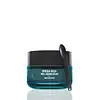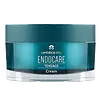What's inside
What's inside
 Key Ingredients
Key Ingredients

 Benefits
Benefits

 Concerns
Concerns

 Ingredients Side-by-side
Ingredients Side-by-side

Aloe Barbadensis Leaf Juice Powder
Skin ConditioningWater
Skin ConditioningPolyglyceryl-3 Cetyl Ether
EmulsifyingCaprylic/Capric Triglyceride
MaskingGlyceryl Stearate
EmollientGlycerin
HumectantPropanediol
SolventCoco-Caprylate/Caprate
EmollientRosa Canina Fruit Oil
EmollientC13-15 Alkane
SolventCetyl Alcohol
EmollientSimmondsia Chinensis Seed Oil
EmollientIsoamyl Laurate
EmollientPrunus Amygdalus Dulcis Oil
Skin ConditioningSesamum Indicum Seed Oil
EmollientCapparis Spinosa Bud Extract
Skin ConditioningMorus Nigra Leaf Extract
Skin ConditioningRhodiola Rosea Root Extract
EmollientCaesalpinia Spinosa Fruit Extract
Skin ProtectingGlycogen
HumectantDimer Dilinoleyl Dimer Dilinoleate
EmollientHyaluronic Acid
HumectantHydrolyzed Rhodophyceae Extract
Hectorite
AbsorbentParfum
MaskingBenzyl Alcohol
PerfumingArginine
MaskingLevulinic Acid
PerfumingSodium Gluconate
Skin ConditioningSuccinoglycan
Skin ConditioningMalic Acid
BufferingSodium Levulinate
Skin ConditioningIsoamyl Cocoate
Xanthan Gum
EmulsifyingP-Anisic Acid
MaskingDehydroacetic Acid
PreservativeGlycine Soja Oil
EmollientTocopherol
AntioxidantBeta-Sitosterol
Emulsion StabilisingSqualene
EmollientMaris Sal
Skin ConditioningAloe Barbadensis Leaf Juice Powder, Water, Polyglyceryl-3 Cetyl Ether, Caprylic/Capric Triglyceride, Glyceryl Stearate, Glycerin, Propanediol, Coco-Caprylate/Caprate, Rosa Canina Fruit Oil, C13-15 Alkane, Cetyl Alcohol, Simmondsia Chinensis Seed Oil, Isoamyl Laurate, Prunus Amygdalus Dulcis Oil, Sesamum Indicum Seed Oil, Capparis Spinosa Bud Extract, Morus Nigra Leaf Extract, Rhodiola Rosea Root Extract, Caesalpinia Spinosa Fruit Extract, Glycogen, Dimer Dilinoleyl Dimer Dilinoleate, Hyaluronic Acid, Hydrolyzed Rhodophyceae Extract, Hectorite, Parfum, Benzyl Alcohol, Arginine, Levulinic Acid, Sodium Gluconate, Succinoglycan, Malic Acid, Sodium Levulinate, Isoamyl Cocoate, Xanthan Gum, P-Anisic Acid, Dehydroacetic Acid, Glycine Soja Oil, Tocopherol, Beta-Sitosterol, Squalene, Maris Sal
Water
Skin ConditioningC12-20 Acid PEG-8 Ester
EmulsifyingSnail Secretion Filtrate
Skin ConditioningGlycerin
HumectantHydrolyzed Soy Protein
HumectantPentylene Glycol
Skin ConditioningSaccharide Isomerate
HumectantHexylene Glycol
EmulsifyingLimnanthes Alba Seed Oil
Skin ConditioningCaprylic/Capric Triglyceride
MaskingCetyl Alcohol
EmollientPPG-15 Stearyl Ether
EmollientTocopheryl Acetate
AntioxidantFructose
HumectantGlucose
HumectantPhenoxyethanol
PreservativeUrea
BufferingSodium Lactate
BufferingLactic Acid
BufferingSerine
MaskingSorbitol
HumectantMethylparaben
PreservativeDextrin
AbsorbentSucrose
HumectantSodium Citrate
BufferingSodium Chloride
MaskingDisodium EDTA
Propylparaben
PreservativeAllantoin
Skin ConditioningAlanine
MaskingAspartic Acid
MaskingGlutamic Acid
HumectantHexyl Nicotinate
EmollientParfum
MaskingGeraniol
PerfumingLinalool
PerfumingHexyl Cinnamal
PerfumingLimonene
PerfumingBenzyl Salicylate
PerfumingButylphenyl Methylpropional
PerfumingWater, C12-20 Acid PEG-8 Ester, Snail Secretion Filtrate, Glycerin, Hydrolyzed Soy Protein, Pentylene Glycol, Saccharide Isomerate, Hexylene Glycol, Limnanthes Alba Seed Oil, Caprylic/Capric Triglyceride, Cetyl Alcohol, PPG-15 Stearyl Ether, Tocopheryl Acetate, Fructose, Glucose, Phenoxyethanol, Urea, Sodium Lactate, Lactic Acid, Serine, Sorbitol, Methylparaben, Dextrin, Sucrose, Sodium Citrate, Sodium Chloride, Disodium EDTA, Propylparaben, Allantoin, Alanine, Aspartic Acid, Glutamic Acid, Hexyl Nicotinate, Parfum, Geraniol, Linalool, Hexyl Cinnamal, Limonene, Benzyl Salicylate, Butylphenyl Methylpropional
Ingredients Explained
These ingredients are found in both products.
Ingredients higher up in an ingredient list are typically present in a larger amount.
This ingredient is an emollient, solvent, and texture enhancer. It is considered a skin-softener by helping the skin prevent moisture loss.
It helps thicken a product's formula and makes it easier to spread by dissolving clumping compounds.
Caprylic Triglyceride is made by combining glycerin with coconut oil, forming a clear liquid.
While there is an assumption Caprylic Triglyceride can clog pores due to it being derived from coconut oil, there is no research supporting this.
Learn more about Caprylic/Capric TriglycerideCetyl Alcohol is a fatty alcohol. Fatty Alcohols are most often used as an emollient or to thicken a product.
Its main roles are:
Though it has "alcohol" in the name, it is not related to denatured alcohol or ethyl alcohol.
The FDA allows products labeled "alcohol-free" to have fatty alcohols.
Learn more about Cetyl AlcoholGlycerin is already naturally found in your skin. It helps moisturize and protect your skin.
A study from 2016 found glycerin to be more effective as a humectant than AHAs and hyaluronic acid.
As a humectant, it helps the skin stay hydrated by pulling moisture to your skin. The low molecular weight of glycerin allows it to pull moisture into the deeper layers of your skin.
Hydrated skin improves your skin barrier; Your skin barrier helps protect against irritants and bacteria.
Glycerin has also been found to have antimicrobial and antiviral properties. Due to these properties, glycerin is often used in wound and burn treatments.
In cosmetics, glycerin is usually derived from plants such as soybean or palm. However, it can also be sourced from animals, such as tallow or animal fat.
This ingredient is organic, colorless, odorless, and non-toxic.
Glycerin is the name for this ingredient in American English. British English uses Glycerol/Glycerine.
Learn more about GlycerinParfum is a catch-all term for an ingredient or more that is used to give a scent to products.
Also called "fragrance", this ingredient can be a blend of hundreds of chemicals or plant oils. This means every product with "fragrance" or "parfum" in the ingredients list is a different mixture.
For instance, Habanolide is a proprietary trade name for a specific aroma chemical. When used as a fragrance ingredient in cosmetics, most aroma chemicals fall under the broad labeling category of “FRAGRANCE” or “PARFUM” according to EU and US regulations.
The term 'parfum' or 'fragrance' is not regulated in many countries. In many cases, it is up to the brand to define this term.
For instance, many brands choose to label themselves as "fragrance-free" because they are not using synthetic fragrances. However, their products may still contain ingredients such as essential oils that are considered a fragrance by INCI standards.
One example is Calendula flower extract. Calendula is an essential oil that still imparts a scent or 'fragrance'.
Depending on the blend, the ingredients in the mixture can cause allergies and sensitivities on the skin. Some ingredients that are known EU allergens include linalool and citronellol.
Parfum can also be used to mask or cover an unpleasant scent.
The bottom line is: not all fragrances/parfum/ingredients are created equally. If you are worried about fragrances, we recommend taking a closer look at an ingredient. And of course, we always recommend speaking with a professional.
Learn more about ParfumWater. It's the most common cosmetic ingredient of all. You'll usually see it at the top of ingredient lists, meaning that it makes up the largest part of the product.
So why is it so popular? Water most often acts as a solvent - this means that it helps dissolve other ingredients into the formulation.
You'll also recognize water as that liquid we all need to stay alive. If you see this, drink a glass of water. Stay hydrated!
Learn more about Water